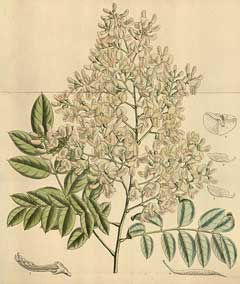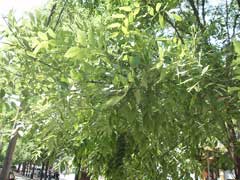 |
|
http://commons.wikimedia.org/wiki/File:Sophora_japonica_144-8764.jpg |
 |
| http://commons.wikimedia.org/wiki/User:Fanghong |
Translate this page:
Summary
Bloom Color: White, Yellow. Main Bloom Time: Early summer, Late summer, Mid summer. Form: Rounded.
Physical Characteristics

 Styphnolobium japonicum is a deciduous Tree growing to 20 m (65ft) by 20 m (65ft) at a fast rate.
Styphnolobium japonicum is a deciduous Tree growing to 20 m (65ft) by 20 m (65ft) at a fast rate.
See above for USDA hardiness. It is hardy to UK zone 5 and is not frost tender. It is in flower in September, and the seeds ripen in November. The species is hermaphrodite (has both male and female organs) and is pollinated by Insects.
It can fix Nitrogen.
Suitable for: light (sandy), medium (loamy) and heavy (clay) soils, prefers well-drained soil and can grow in nutritionally poor soil. Suitable pH: mildly acid, neutral and basic (mildly alkaline) soils. It cannot grow in the shade. It prefers moist soil and can tolerate drought. It can tolerate atmospheric pollution.
UK Hardiness Map
US Hardiness Map
Synonyms
Styphnolobium japonicum
Plant Habitats
Edible Uses
Young leaves and flowers - cooked[177, 183]. The leaves need to be cooked in three lots of water in order to remove the bitterness[179]. This will also remove most of the vitamins and minerals[K]. The leaves are a rich source of rutin, they contain much more than the usual commercial source, buckwheat (Fagopyrum esculentum)[174]. The ovaries, before the flowers open, contain up to 40% rutin[218]. A tea can be made from the young leaves and flowers[183]. An edible starch is obtained from the seed[183].
References More on Edible Uses
Medicinal Uses
Plants For A Future can not take any responsibility for any adverse effects from the use of plants. Always seek advice from a professional before using a plant medicinally.
This species is commonly used in Chinese medicine and is considered to be one of the 50 fundamental herbs[218]. It came second in a study of 250 potential antifertility agents[218]. Diuretic, emollient, febrifuge, tonic[11, 147, 174, 178]. The flowers and flower buds are antibacterial, anticholesterolemic, anti-inflammatory, antispasmodic, haemostatic and hypotensive[11, 147, 174, 176, 178, 218, 238, 279]. The ovaries, especially just before the plant flowers, are a rich source of rutin and this is a valuable hypotensive agent[218]. The buds, flowers and pods are concocted and used in the treatment of a variety of ailments[218] including internal haemorrhages, poor peripheral circulation, internal worms etc[238]. This remedy should not be prescribed for pregnant women[238]. The seedpods are abortifacient[218]. The seed is emetic and haemostatic[218]. It is used in the treatment of haemorrhoids, haematuria, uterine bleeding, constipation, stuffy sensation in the chest, dizziness, red eyes, headache and hypertension[176].It should be used with caution since it is toxic[218]. The leaves are laxative[218]. They are used in the treatment of epilepsy and convulsions[218]. A decoction of the stems is used in the treatment of piles, sore eyes and skin problems[218].
References More on Medicinal Uses
The Bookshop: Edible Plant Books
Our Latest books on Perennial Plants For Food Forests and Permaculture Gardens in paperback or digital formats.

Edible Tropical Plants
Food Forest Plants for Hotter Conditions: 250+ Plants For Tropical Food Forests & Permaculture Gardens.
More

Edible Temperate Plants
Plants for Your Food Forest: 500 Plants for Temperate Food Forests & Permaculture Gardens.
More

More Books
PFAF have eight books available in paperback and digital formats. Browse the shop for more information.
Shop Now
Other Uses
A yellow dye is obtained from the seedpods and the flowers[46, 61, 109, 178]. It is green when mixed with indigo[151]. Wood - tough, light, strong, of superior quality. Used in carpentry[109, 174].
Special Uses
References More on Other Uses
Cultivation details
Landscape Uses:Firewood, Pest tolerant, Specimen, Street tree. Succeeds in a well-drained moderately fertile soil in full sun[200]. Tolerates poor soils, atmospheric pollution, heat and, once established, drought[200]. Hardy to about -25° when mature, but it can be damaged by severe frosts when it is young[200]. A very ornamental[1] and fast growing tree[200], it grows best in hot summers[188]. It grows best in the warmer areas of the country where the wood will be more readily ripened and better able to withstand winter cold[219]. Trees take 30 years to come into flower from seed.[200], but they do not often ripen their seed in Britain[11]. Cultivated in China for the rutin contained in its leaves and ovaries[218]. Plants should be container-grown and planted out whilst young, older plants do not transplant well[219]. Plants in this genus are notably resistant to honey fungus[200]. This species has a symbiotic relationship with certain soil bacteria, these bacteria form nodules on the roots and fix atmospheric nitrogen. Some of this nitrogen is utilized by the growing plant but some can also be used by other plants growing nearby[200]. Special Features:
Not North American native, Attractive flowers or blooms. The plant is heat tolerant in zones 9 through 5. (Plant Hardiness Zones show how well plants withstand cold winter temperatures.
Plant Heat Zones show when plants would start suffering from the heat.
The Plant Heat Zone map is based on the number of "heat days" experienced in a given area where the temperature climbs to over 86 degrees F (30°C).
At this temperature, many plants begin to suffer physiological damage. Heat Zones range from 1 (no heat days) to 12 (210 or more heat days).
For example Heat Zone. 11-1 indicates that the plant is heat tolerant in zones 11 through 1.) For polyculture design as well as the above-ground architecture (form - tree, shrub etc. and size shown above) information on the habit and root pattern is also useful and given here if available. The plant growth habit is a standard with a non-suckering single trunk [1-2].
References Carbon Farming Information and Carbon Sequestration Information
Temperature Converter
Type a value in the Celsius field to convert the value to Fahrenheit:
Fahrenheit:
The PFAF Bookshop
Plants For A Future have a number of books available in paperback and digital form. Book titles include Edible Plants, Edible Perennials, Edible Trees,Edible Shrubs, Woodland Gardening, and Temperate Food Forest Plants. Our new book is Food Forest Plants For Hotter Conditions (Tropical and Sub-Tropical).
Shop Now
Plant Propagation
Seed - best sown as soon as it is ripe in a greenhouse[200]. Pre-soak stored seed for 12 hours in hot (not boiling) water and sow in late winter in a greenhouse[78]. Prick out the seedlings as soon as they are large enough to handle into individual pots in the greenhouse, and grow them on for 2 years under protected conditions. Plant them out into their permanent positions in early summer of their third year. Cuttings of young shoots with a heel, July/August in a frame[11]. Air-layering[200].
Other Names
If available other names are mentioned here
Native Range
TEMPERATE ASIA: Anhui Sheng, Fujian Sheng, Guangdong Sheng, Guizhou Sheng, Hebei Sheng, Henan Sheng, Hubei Sheng, Jiangsu Sheng, Jiangxi Sheng, Shaanxi Sheng, Shandong Sheng, Sichuan Sheng, Yunnan Sheng, Zhejiang Sheng,China.
Weed Potential
Right plant wrong place. We are currently updating this section.
Please note that a plant may be invasive in one area but may not in your area so it's worth checking.
Conservation Status
IUCN Red List of Threatened Plants Status :

Growth: S = slow M = medium F = fast. Soil: L = light (sandy) M = medium H = heavy (clay). pH: A = acid N = neutral B = basic (alkaline). Shade: F = full shade S = semi-shade N = no shade. Moisture: D = dry M = Moist We = wet Wa = water.
Now available:
Food Forest Plants for Mediterranean Conditions
350+ Perennial Plants For Mediterranean and Drier Food Forests and Permaculture Gardens.
[Paperback and eBook]
This is the third in Plants For A Future's series of plant guides for food forests tailored to
specific climate zones. Following volumes on temperate and tropical ecosystems, this book focuses
on species suited to Mediterranean conditions—regions with hot, dry summers and cool, wet winters,
often facing the added challenge of climate change.
Read More
Expert comment
Author
L.
Botanical References
11109200
Links / References
For a list of references used on this page please go here
Readers comment
| Add a comment |
|
If you have important information about this plant that may help other users please add a comment or link below. Only comments or links that are felt to be directly relevant to a plant will be included. If you think a comment/link or information contained on this page is inaccurate or misleading we would welcome your feedback at [email protected]. If you have questions about a plant please use the Forum on this website as we do not have the resources to answer questions ourselves.
* Please note: the comments by website users are not necessarily those held by PFAF and may give misleading or inaccurate information.
To leave a comment please Register or login here All comments need to be approved so will not appear immediately.
|
Subject : Styphnolobium japonicum
|
|
|
|